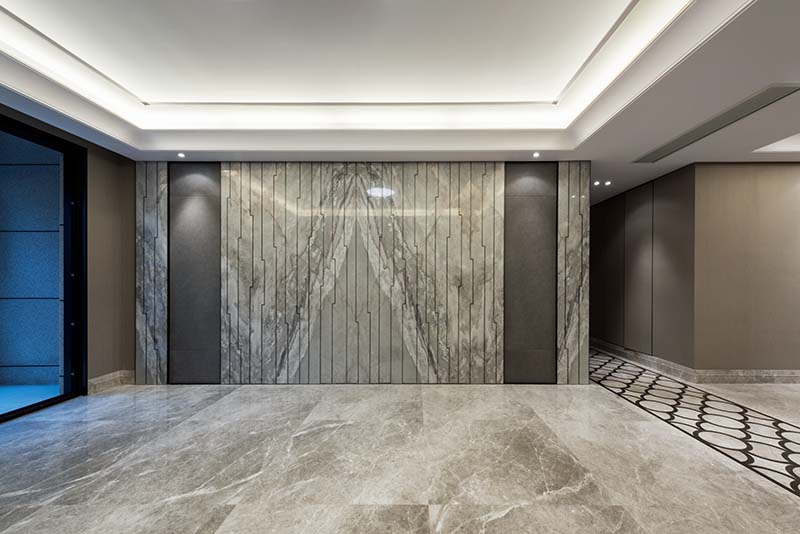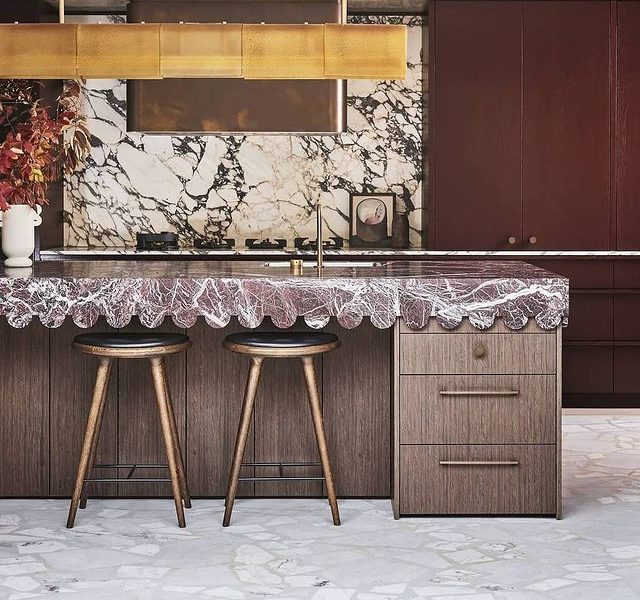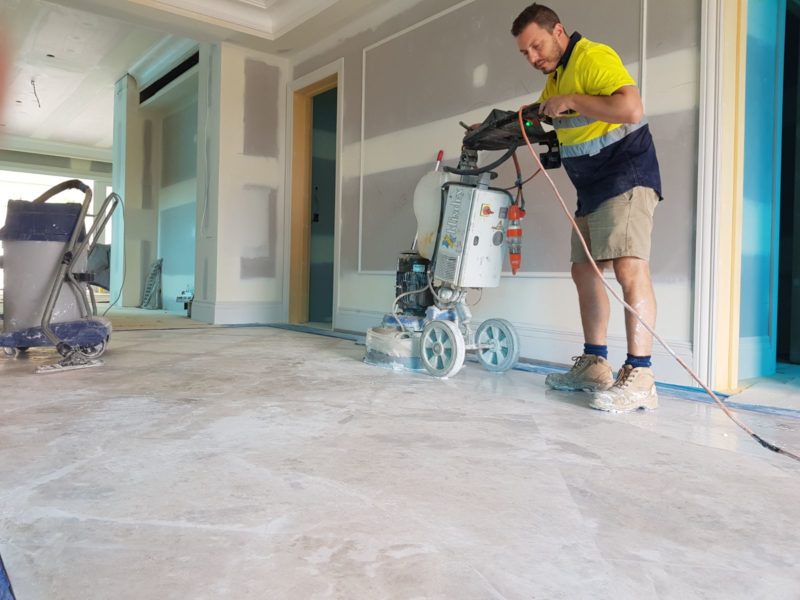
Care and Maintenance of Natural Stone
Know Your Stone
Natural stone can be classified into two general categories according to its composition: siliceous stone or calcareous stone. Knowing the difference is critical when selecting cleaning products.
Siliceous stone is composed mainly of silica or quartz-like particles. It tends to be very durable
and relatively easy to clean with mild acidic cleaning solutions. Types of siliceous stone include granite, slate, sandstone, quartzite, brownstone, and bluestone.
Calcareous stone is composed mainly of calcium carbonate. It is sensitive to acidic cleaning products and frequently requires different cleaning procedures than siliceous stone. Types of calcareous stone include marble, travertine, limestone, and onyx. What may work on the siliceous stone may not be suitable for calcareous surfaces.
Eyedropper Test
Because the test may permanently etch the stone, select an out-of-the-way area (a corner or closet) several inches away from any mortar joint. Apply a few drops of the acid solution to the stone surface on an area about the size of a quarter. Two possible reactions will occur:
1) Acid drops will bubble or fizz vigorously – a sign that the stone is calcareous.
2) Little or no reaction occurs – stone can be considered siliceous. See note below.
Rinse the area thoroughly with clean water and wipe dry.
NOTE: This test may not be effective if surface sealers or liquid polishes have been applied. If an old sealer is present, chip a small piece of the stone away and apply the acid solution to the fractured surface.
CAUTION: Muriatic acid is corrosive and is considered to be a hazardous substance. Proper head and body protection is necessary when acid is used. Again, it is always wise to consult with a stone professional if you are unable to visually identify the stone and/or are uncomfortable using the acid test.
• Sandstones vary widely in color due to different minerals and clays found in the stone. Sandstone is light gray to yellow or red.
• Slates are dark green, black, gray, dark red, or multi-colored. They are most commonly used as a flooring material and for roof tiles and are often distinguished by distinct cleft texture. Some notable
What Type of Stone Is It?
It is advisable to maintain careful records about the type, name, and origin of the stone existing in your building. If such records do not exist, you should explore the following options before determining a cleaning and maintenance program:
1. Consult with a professional stone supplier, installer, or a restoration specialist to help identify whether your stone is siliceous or calcareous.
2. Conduct a visual identification of the stone. While there are exceptions, the following characteristics are common:
• Granites have a distinct crystal pattern or small flecks; very little veining.
• Limestones are widely used as a building stone. Colors are typically gray, tan, or buff. A distinguishing characteristic of many limestones is the presence of shell and/or fossil impressions.
• Marbles are usually veined, fine-textured materials that come in virtually unlimited color selections.
cladding projects have also included slate. Sandstones vary widely in color due to different minerals and clays found in the stone. Sandstone
• Slates are dark green, black, gray, dark red, or multi-colored. They are most commonly used as a flooring material and for roof tiles and are often distinguished cladding projects have also included slate.
Assessing the Stone’s Current Condition
Knowing the current condition of the stone is another critical first step. It is recommended that you develop a checklist of questions to use in your routine examination of the current conditions. Your checklist should include questions such as:
• Are the tiles flat and even?
• Are there any cracked tiles?
• What type of stone finish exists?
Care and Precautions
Countertops: General guidelines for both siliceous and calcareous stones:
Use coasters under all glasses, particularly those containing alcohol or citrus juices. Do not place hot items right off a stove or out of an oven directly on the stone surface.
Use trivets or mats under hot dishes and placemats under china, ceramics, silver, or other objects that can scratch the surface.
For calcareous stones, many common foods and drinks contain acids that will etch or dull the stone surface.
• Has the stone been coated with any waxes, acrylics, enhancers, or other coatings? If so,
which type and manufacturer?
• Is there any evidence of staining? What type?
• If the stone has been sealed with a topical sealer, are there any signs that the sealer has worn off?
Your answers to these and other questions will help you pinpoint your next step.
For example:
• Uneven tiles (a sign of lippage) may result in the floor needing to be ground flat, honed, and then polished.
• Cracked tiles will allow dirt and other debris to accumulate in the cracks. This may require that the tiles be replaced, or at a minimum, filled.
• Knowing the type of stain (organic, oil-based, etc.) will help identify the proper stain removal technique needed. Also, the level of stains or spills the stone can be exposed to will play a role in determining if an application of a sealer is appropriate.
Flooring Surfaces: Many flooring surfaces can become slippery when wet. When wet conditions occur, reduce potential hazards by doing the following:
1. Spread carpeted runners from each outside door into lobbies and corridors to help dry shoe soles.
2. Place bright-colored “slippery when wet” pylons on walking surfaces in conspicuous places.
3.Mop or shovel walking surfaces as often as necessary to remove standing water, ice, and/or snow.
4. Issue standard instructions to building maintenance personnel and prominently post at all janitorial workstations.
5. Follow local building and safety codes.
General Guidelines for Stain Removal
1. Remove any loose debris.
2. Blot spills; wiping the area will spread the spill.
3. Flush the area with plain water and mild soap and rinse several times.
4. Dry the area thoroughly with a soft cloth. 5. Repeat as necessary.
6. If the stain remains, refer to the section in this guide on stain removal.
7. If the stain persists or for problems that appear too difficult to treat, call your stone care professional,
installer, or restoration specialist.
Natural Stone Cleaning Do’s and Don’ts
When discussing care and cleaning procedures with your maintenance staff, there are recommended do’s and don’ts that should always be followed:
Do dust mop floors frequently.
Do clean surfaces with mild detergent or stone soap.
Do thoroughly rinse and dry the surface with clean, clear water after washing.
Do blot up spills immediately.
Do protect floor surfaces with non-slip mats or area rugs and countertop surfaces with coasters, trivets, or placemats.
Don’t use vinegar, lemon juice, or other cleaners containing acids on marble, limestone, travertine, or onyx surfaces.
Don’t use cleaners that contain acids such as bathroom cleaners, grout cleaners, or tub & tile cleaners.
Don’t use abrasive cleaners such as dry cleansers or soft cleansers.
Don’t mix bleach and ammonia; this combination creates a toxic and lethal gas.
Don’t ever mix chemicals together unless directions specifically instruct you to do so.
Don’t use vacuum cleaners that are worn. The metal or plastic attachments or the wheels may scratch the stone’s surface.
Sealing Natural Stone
Several factors must be considered prior to determining if the stone should be sealed:
The type of stone, its finish, its location, and how
it is maintained all need to be considered when determining how to protect the stone.
• What is hardness, density, and durability of stone?
• How porous is the stone and how fast will it absorb a liquid (also referred to as the absorption coefficient)?
• Is the stone expected to be in frequent contact with a staining agent?
In some cases, it makes sense to seal the stone. Once properly sealed, the stone will be protected against everyday dirt and spills. In other cases, it is best to leave the stone untreated. Topical sealers can alter the surface texture and finish as well as build upon the surface, creating a layer that is less
• What type of finish was applied to the surface?
durable than the stone. Generally, topical sealers are not recommended in exterior applications because they can trap moisture within the top layer of the stone, which may lead to surface deterioration during freeze/thaw cycles.
For example, a polished surface is more resistant to staining than a honed surface.
• Will the sealant affect the color or other aesthetics of the stone?
• If a resin was applied to the stone, how will the sealant react with the resin?
• Where is the stone located (e.g. countertop, floor, wall, foyer, bathroom, etc.)? Residential
or commercial?
• What type of maintenance program has the stone been subjected to?
The type of stone, its finish, its location, and how
it is maintained all need to be considered when determining how to protect the stone.
Once properly sealed, the stone will be protected against everyday dirt and spills. Topical sealers can alter the surface texture and finish as well as build upon the surface, creating a layer that is less durable than the stone. Generally, topical sealers are not recommended in exterior applications because they can trap moisture within the top layer of the stone, which may lead to surface deterioration during freeze/thaw cycles.
If you have decided to treat your stone, make sure you understand the differences between the types of sealers available on the market:
• Topical Sealers are coatings (film formers) designed to protect the surface of the stone
against water, oil, and other contaminants. They are formulated from natural wax, acrylic, and other plastic compounds. When a topical sealer is applied, the maintenance program often shifts from a program focused on stone care to a program focused on the maintenance of the sealer (for example: stripping and reapplication).
• Impregnators are water- or solvent-based solutions that penetrate below the surface and become repellents. They are generally hydrophobic(water-repelling) but are also oleophobic (oil-repelling). Impregnators keep contaminants out but do not stop the interior moisture from escaping. These products are considered “breathable,” meaning they have vapor transmission.
to have an impregnator applied. Check with your installer for recommendations. If an impregnator is applied, be sure that it is safe for use on food preparation surfaces. If there are questions, check with the product manufacturer.
Before sealing, always:
• Read the Manufacturers Warranty and Instructions.
• Contact the manufacturer prior to application if you are unsure or need clarification. The woodworking analogy of ‘measure twice, cut once’applies
• Consider the lifespan of the application (1-year, 2-years, 5-years, etc.) – keep a log of each
application.
• Don’t switch from one product to another without fully understanding any potential issues. Not all products are alike – again, consult with the manufacturers.
• Consult with your stone professional as necessary.
• Ask yourself, does the stone need to be treated in the first place?
Daily Cleaning Procedures and Recommendations
Floor Surfaces
Dust mop interior floors frequently using a clean, non- treated dry dust mop. Sand, dirt, and grit do the most damage to natural stone surfaces due to their abrasiveness. Mats or area rugs inside and outside an entrance will help to minimize the sand, dirt, and grit that will scratch the stone floor. Be sure that the underside of the mat or rug is a non-slip surface. Normally, it will take a person about eight steps
on a floor surface to remove sand or dirt from the bottom of their shoes.
Normal maintenance involves periodic washing with clean, potable water and neutral (pH 7) cleaners. Soapless cleaners are preferred because they minimize streaks and film. Mild, phosphate-free, biodegradable liquid dishwashing soaps or powders or stone soaps are acceptable if rinsing is thorough.
Wet the stone surface with clean water. Using the cleaning solution (following manufacturer’s directions), wash in small, overlapping sweeps. Work from the bottom up if it is a vertical surface. Rinse thoroughly with clean, potable water to remove all traces of soap or cleaner solution. Change the water in the rinse pail frequently. Dry with a soft cloth and allow to thoroughly dry.
Soap scum can be minimized by using a squeegee after each use. To remove soap scum, use a non-acidic soap scum remover or a solution of ammonia and water (about 1/2 cup ammonia to a gallon of water). Frequent or over-use of an ammonia solution may eventually dull the surface of the stone.
Exterior Stone Surfaces
The large expanses of stone generally found on exterior applications may make it impractical to
perform normal maintenance on a frequent basis. Large installations, however, should be given periodic overall cleaning as necessary to remove accumulated pollutants. Easily accessible stone surfaces such as steps, walkways, fountains, etc., should be kept free of debris and soiling by periodically sweeping and wash- ing with water.
Normal maintenance should include periodic inspection of stone surfaces for structural defects, movement, deterioration, or staining.





